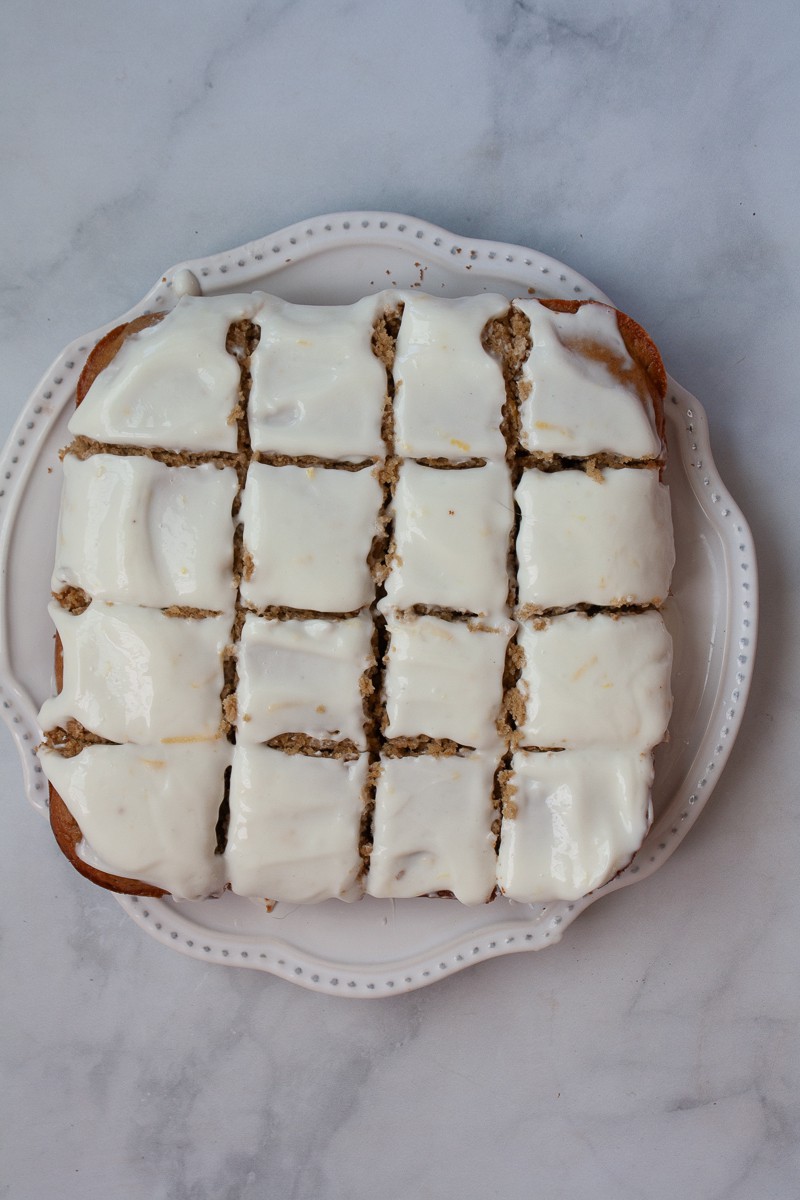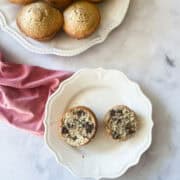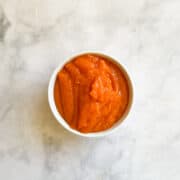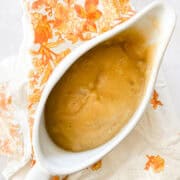Versatile and delicious oat flour is fantastic in gluten free baking as well as conventional baking. Wondering how to use it? Here's all you need to know about baking with oat flour.

Oat flour is one of the underrated stars of baking's universe. It is the secret weapon in gluten free baking, performing similarly to wheat flour in taste and texture, and it can also be used to elevate conventional baked goods with a hit of whole grains. You can use oat flour in practically any recipe - its delicate, slightly buttery undertone also contains traces of caramel yet it never overpowers the other flavors in the dish - and it bakes up perfectly fluffy and tender. It is absolutely my favorite flour to use in baking recipes.
Plus, oat flour is an amazingly economical gluten-free flour! You can easily buy packages in bulk online (my favorite brand of oat flour is sold by Anthony's. This oat flour is certified gluten-free and comes in large 5-pound bags that keep well and last a while!). Many grocery stores also sell oat flour (both Whole Foods as well as the small grocery store in my town sell packages of Bob's Red Mill brand gluten-free oat flour), making it a quick and easy choice. Even better, you can turn the oats in your pantry into oat flour by whizzing them in the blender.
So now you know that oat flour is, well, awesome. Let's dig in a little deeper and explore more about this great gluten free flour!

What Is Oat Flour?
Oat flour is a gluten free flour that's made from, you guessed it, oats! To produce oat flour, oats are finely ground to form a flour. That's it! Oat flour is a whole grain, naturally gluten-free flour that has a slight sweetness when it’s used in baked goods (another reason it's perfect in all sorts of desserts and sweet bakes). It’s packed with protein, fiber, calcium, manganese, selenium, phosphorous, and magnesium, making it a great alternative choice to or in addition to all-purpose flour.

Is Oat Flour Gluten Free?
Oats in their natural state are gluten-free, so this means that oat flour is also gluten free. However, as is typical when we're discussing the realm of gluten free, if you are celiac or very sensitive to gluten, you’ll want to purchase oat flour that is labeled as being gluten-free or “certified gluten-free” to be on the absolute safe side.
The reason for purchasing certified gluten-free oats or oat flour is that cross-contamination (meaning that the oats could have come in contact with gluten-containing products) is always a possibility during the manufacturing process for regular oats. So check the labels on your package of oats or oat flour before you buy it and make sure you see the "gluten free" wording before taking it home.
Can I Use Oat Flour If I Have a Gluten Intolerance?
If you have Celiac Disease or a gluten intolerance, you can eat oats and oat flour because they don’t contain gluten. However, some who have been diagnosed with Celiac Disease also are sensitive to oats, which contain a protein called Avenin. Unfortunately, this may cause a reaction similar to when you eat gluten if you’re very sensitive. If you find you’re sensitive to oats, you’ll have to avoid oat flour.

Why Bake with Oat Flour?
Oat flour is your gluten free baking secret weapon! When you embark on baking with oat flour, you'll be rewarded with tender, moist cakes, chewy cookies, plushy muffins, and more. You can use oat flour on its own, or pair it with other gluten free flours such as almond flour or a starchy gluten free flour like tapioca or arrowroot to lighten it up a bit. However, I find that most of the time you can use only oat flour with stellar results. More on this lower down.
In traditional wheat flour baking, substituting oat flour for part of the all-purpose flour in the recipe can keep the results moist and lighter and add a bit of whole grain punch. Oat flour also lends a subtle flavor that can be pleasing when paired with all-purpose or whole wheat pastry flour.

How to Bake with Oat Flour
Treat oat flour as you would any flour, with a few gluten free caveats -
- you'll need to build in a few extra minutes to hydrate the dough
- you'll want to include a binder, such as eggs, to help build structure
- it's helpful to weigh your oat flour (and use a recipe that includes weight measurements for accuracy)
- use a recipe that's been developed specifically to include oat flour
- pair it with a starchy gluten free flour if you want to add a little bit of lightness
In Traditional Recipes
In traditional baking recipes, oat flour certainly has a place! You can swap 25% of the all-purpose flour in a recipe for oat flour. and replacing it with an equal amount of oat flour. I love pairing oat flour with whole wheat flour or whole wheat pastry flour for an entirely whole grain batter or dough.
Oat flour is also useful when making bread. You can use it when you're kneading a bread dough - dust your work surface with oat flour and knead a little into the dough while you're working it. The oat flour will keep the dough from sticking but it won't toughen the dough.

Tips for Baking with Oat Flour
Let's run through some of my best tips for baking with oat flour:
- Measure oat flour by weight: Yes, I am an advocate for using a kitchen scale, especially in gluten-free baking. Oat flour baking is a prime example of why this is so important: oat flour weighs less than all-purpose flour, so if you wish to substitute some or all of the flour in a recipe measuring by cups may not work out so well. However, I know that not everyone has a scale! If you can't measure your flour by weight, you can try 1 ¼ cups of oat flour per 1 cup of all-purpose flour with decent results.
- Easy to DIY: Oat flour is beyond easy to make yourself, all you need is a food processor or blender. See how to make oat flour in this post.
- Hydrate the batter: Oat flour performs its best when it's been treated to a short period of hydration so that it can soak up the liquid in the batter. My general practice is to let a batter rest in the prepared pan while the oven preheats. This 10-15 rest period is sufficient to hydrate the batter.
- For dough: In terms of cookie dough made with oat flour, the hydration period is also essential and you can let it sit even longer in the fridge. For sugar cookies or chocolate chip cookies, I'll rest the batter in the fridge for at least 1 hour and up to 24 hours.
- Refrigeration can help: For other dough recipes, such as in my oat flour cinnamon rolls, if a dough is sticky or difficult to work with, a 15-minute rest in the fridge can bring it together without the need for extra flour. In these types of doughs, too much flour can result in a heavy or gummy baked good, so try the refrigerated rest period before adding in any more oat flour.

Can I Use Oat Flour Instead of All Purpose Flour?
I believe you can use oat flour instead of all-purpose flour in many recipes, despite it being a gluten free flour. Baking with oat flour is not difficult if you follow the best practices outlined above!
Subsitution troubles can arise difficulty comes in when you try to sub oat flour in recipes that don’t list the weight measurements – did you know that the range for a cup of wheat flour can range from 120-145 grams? Because of this discrepancy, I don’t recommend substituting oat flour for all-purpose flour unless the weight measurements are given in the ingredients list.
If you try to make a substitute without weighing the flour, the ratios may be off, leading to a wet or soggy final product. This is a reason why I always include both the weight measurements in grams and cup measurements so that my recipes can be made with gluten-free flour OR all-purpose flour as needed.
How to Substitute Oat Flour
In conventional baking, the general rule of thumb is to substitute about 25% of all-purpose flour in a recipe with oat flour or to choose a recipe that’s specifically written to include oat flour. You can follow this ratio when creating a gluten free flour blend - use 25% oat flour, then add in other flours of choice (I love a blend of oat flour plus sweet white rice flour and tapioca flour). Or, if you use a pre-made 1:1 gluten free flour blend, substitute ¼ cup of oat flour in the recipe for the gluten free flour.

Recipes that Use Oat Flour
I adore baking with oat flour and am constantly developing recipes on this site that use it as a standalone flour or in combination with one or two other simple gluten free flours. I've rounded up a big batch of oat flour recipes, or you can type "oat flour" into the search bar for all the latest recipes for oat flour baking. All of the photos in this post feature recipes baked just with oat flour!

















Marjorie Hancock says
New to using oat flour. So far I’ve only baked banana bread. It was yummy! I’m moving forward in my baking. My daughters and I bake at Christmas, yummy goodness and send to family throughout the United States. Can I substitute oat flour for most recipes?
Nicole Spiridakis says
Hi Marjorie, I love baking with oat flour! Yes you can substitute it in many recipes but I recommend using weight measurements when possible. 1 cup of oat flour weighs 120 grams, which can be the same as a cup of all-purpose flour depending on the way the recipe was developed. If there are no weight measurements you can try it 1:1 or do 1 1/4 cups of oat flour per cup of all-purpose flour. Hope that helps!